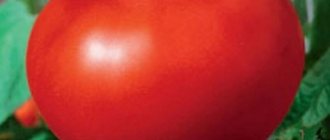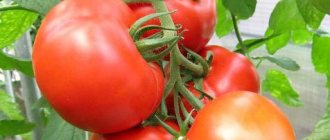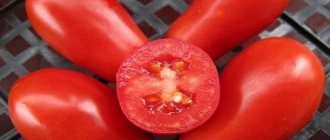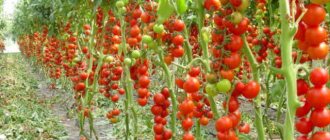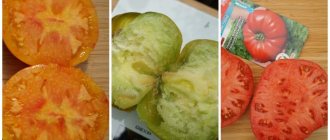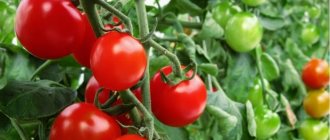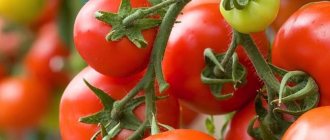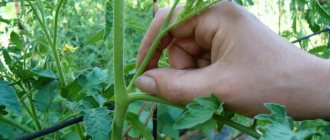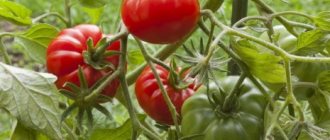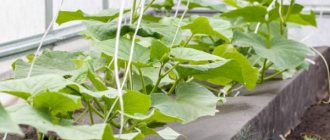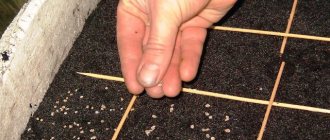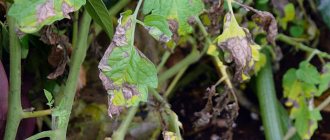The best varieties of tomatoes for open ground are the most delicious and large-fruited
The largest-fruited varieties and their detailed characteristics
For many summer residents, the size of the vegetable grown matters. They have an excellent appearance for trading at the market, they can be shown off to a neighbor or simply served as a decoration. Their taste qualities, as a rule, are slightly inferior to small fruits, but growing a couple of bushes of such vegetables will not hurt every summer resident. We present to your attention the largest-fruited varieties of tomatoes for open ground and their detailed descriptions.
- Pudovik. Powerful. A tall bush (up to 150 cm), which produces up to a dozen fruits weighing from 200 g to 1 kg. The Pudovik tomato is considered one of the largest in Russia; it is grown in almost all regions, even in the northern ones. The period until technical ripeness is 115 days, considered mid-early. The yield is 5 kg from one bush or up to 17 kg per 1 m2. With good feeding with mineral fertilizers, the plant’s immunity becomes much stronger.
- Tolstoy. It is impossible to consider the best tomatoes for open ground and not mention this hybrid, which over the 25 years of its existence on the Russian market has become a bestseller, like the Budenovka variety. Its predecessor was the Tolstoy tomato variety, which has been known to all summer residents for at least 20 years. The average fruit weight is 230 grams, which is a good indicator. In addition to its large size, the Tolstoy F1 tomato has another significant advantage - high yield. Collect 12 kg/1 sq.m. This is not a record; this can be obtained on an ordinary summer cottage. The bushes grow up to 120 centimeters, spreading, no pinching is required. Ripening period – 150 days. Tomato Tolstoy is highly resistant to many diseases, including powdery mildew and fusarium wilt.
- Tomato Bull's heart. This is one of the most famous “heavyweights”, which has an excellent appearance, good taste and weighs up to 900 g. The average fruit weighs no more than 300 g, while the first inflorescences produce very large tomatoes, and those that ripen a little later can reach only 100-150 g. Has an excellent decorative appearance - heart shape. The bushes are spreading, erect, powerful, up to 130 centimeters. Bull's heart tomatoes are in great demand among summer residents who grow vegetables for themselves.
Remember that large fruits do not always mean high yields. As a rule, these are more decorative vegetables for home and garden, which have no industrial value. If you seriously decide to engage in vegetable growing, then it would be best for you to choose a hybrid that produces up to 12-20 kg per square meter.
The most productive varieties and their descriptions
Today there is high competition in the field of vegetable growing, so the business must be extremely profitable. Tomato varieties of Dutch selection and some Russian analogues are capable of producing up to 20 kg per square meter, thereby significantly increasing the profitability of vegetable growing. The fruits are small in size, but there are many of them, resulting in high yields. We bring to your attention the most “bright” representatives of this category and descriptions.
- Tomato Diabolic. The yield reaches 700 c/ha when grown on a selection plot; under normal conditions, 400-450 c/ha can be obtained with timely fertilization with minerals . The bushes are not spreading, up to 120 centimeters high, the fruits weigh 120-140 grams and are of regular shape. It has increased lightness and is easily transported over long distances. Suitable for pickling, fresh consumption, seaming and other purposes. Resistance to tomato diseases is very high, especially to Fusarium wilt, anthracosis of fruits and leaves, and brown and white spot. It is in many ways superior to the best Dutch varieties of tomatoes, which are not acclimatized on the territory of the Russian Federation.
- Tomato Bobcat F1. A well-known hybrid that produces fairly good yields (40-50 tons per hectare). The fruits are relatively small, up to 140 g, transport well, and lie well. The bushes grow up to 120 centimeters in height, it is advisable to make pinching so that there are as many lateral layers as possible - the yield increases by about 21-24%. Resistance to anthracosis of leaves and fruits is high, they are practically not subject to Fusarium wilt.
- Tomato Solokha. Large-fruited and high-yielding variety. The bush grows up to 90 centimeters in height, slightly spreading. Tomatoes grow on average up to 150 grams, sometimes reaching 220-250 g, especially if the load on the bush was small, up to two dozen fruits. The average yield is 450 centners, sometimes you can get more if you use drip irrigation.
The taste of hybrids most often leaves much to be desired, since the content of sugar and ascorbic acid in them is minimal. Please note that an aromatic smell should also not be expected from extremely productive varieties, since all their efforts are focused on obtaining a certain tonnage.
If you grow for sale and subsequent sale, then this group of vegetables will be optimal for you. If you want to get tasty, aromatic vegetables on your table, it would be better to give preference to ordinary Russian varieties, which have a large amount of vitamin C and sucrose.
The most resistant tomatoes to diseases and weather conditions
Residents of many regions are trying to find varieties that have solid immunity against pests, fungi, and also high resistance to sharp drops in temperature. First of all, these are areas of Siberia, as well as other northern regions, where there is high humidity and fairly low temperatures in the spring. Let us now consider what would be best to plant in such conditions.
- Tomato Marmande. This is one of the most resistant vegetables, which is practically not affected by fungal diseases and can withstand the attacks of many pests. Moreover, the weight of the fetus reaches 250 g, which is quite a lot for this group. One of the most significant advantages of the plant is its resistance to sudden temperature changes, so seedlings can be planted much earlier than usual, by about 2 weeks.
- Tomato Sevruga. By and large, this is the same Pudovik, only adapted to the conditions of the northern regions. The tomatoes were of Dutch selection, but then they were acclimatized in the Volga region and soon began to spread even in Siberia. The weight of one fruit is 450 grams, sometimes more, the skin is hard, the flesh is dense, it transports well, and lasts a long time. The bush is 140 cm high, no pinching is required, the stems are strong and grow without staking. Grows well in a humid environment, the fungus will not attack.
- Tomato Roma. It is considered one of the highest-yielding hybrids growing in Russia, but, in addition to the fact that it produces 60-70 tons per hectare, it is also extremely resistant to fungal diseases of all types. It is not subject to Fusarium wilt and responds well to temperature changes. The ripening period is 120 days, and the last few weeks can withstand even frosts. The weight of the fruit does not exceed 140 grams, the yield is 25 tons per hectare, the bush is 120 centimeters high, pinching is necessary.
These were “extreme varieties” that can survive in almost any conditions. They ideally combine yield, fruit mass, as well as resistance to various types of pests and diseases. That is why they are in extreme demand.
grounde.ru
Positive personJune 2, 2014Interesting facts, Positive and only
The largest vegetables in the world
Good afternoon dear friends! Today, while preparing breakfast (fresh vegetable salad), we came across large representatives of some classes... and immediately decided to write an entry about the largest representatives of some vegetables. Namely, about the largest tomato, the largest cucumber and the largest cabbage.
Varieties of large-fruited tomatoes for the greenhouse
Tall, large tomatoes are ideal for growing in greenhouse conditions. You just need to tie them up and tie them up especially carefully.
Uncontrolled growth of green mass reduces productivity and makes tomatoes smaller. Large fruits pull the shoots down, which under load can break or break the band. It may be necessary to install supports under the lower hands or secure them in another way.
All large tomatoes grown in open ground can also be planted in polycarbonate greenhouses. There they grow higher than in the beds, but they also produce a larger harvest.
Soviet
Indeterminate tomato of Siberian selection by O. V. Postnikova and V. N. Dederko, accepted by the State Register in 2012.
Designed for greenhouses, but can be grown in open ground, where it is planted at a height:
- 1.2 m in areas of risky farming;
- 1.7 m in the south.
The Soviet tomato variety is mid-season, with round, flattened at the poles, crimson tomatoes weighing 300-500 g. The largest ones show ribbing. The pulp is grainy, sweet and sour, very pleasant taste.
From 1 sq. m harvest 8-9 kg of tomatoes. Formation of 1-2 stems is recommended.
Bull
In 20014, the State Register accepted two varieties created in collaboration with V. N. Dederko and O. V. Postnikova (Siberian Garden): Bugai red and pink. These are determinate large-fruited tomatoes, resistant to temperature fluctuations, up to 1.5 m high. Both are recommended to be grown in 1-2 trunks, with a mandatory garter. They form flat-round, fleshy fruits with a small number of seeds.
In addition to the name, skin color and pulp, tomatoes have other differences:
- The bull is red. Medium ripening period, for cultivation in open and closed ground. The weight of the fruit is about 0.5 kg; if desired, and the ovaries are rationed, you can grow tomatoes weighing up to 1 kg. Per bush yields 6 kg.
- Bugay pink. Medium late ripening. A variety for open ground, heat-resistant, but requiring increased fertilizing. Fruits – 450 g each.
Marshal victory
The newest Siberian tomato, authored by V. N. Dederko, included in the State Register in 2021. Indeterminate, mid-season, forming a powerful bush with strong strong shoots. Designed for greenhouses, can be grown in open beds with proper care.
Tomatoes are actually large even without rationing. On the lower hands - 300-400 g, when topping and pinching - up to 1 kg. The flat-round fruits are ribbed, shiny, very tasty - good for processing and on the table. Productivity per sq. m – 10-12 kg.
Grandma's secret
Indeterminate tomato, created by Siberian breeders V.N. Dederko and T.N. Postnikova, accepted by the State Register in 2007. Designed for greenhouses; planting in open ground is not recommended.
The tomatoes are flattened, often with a protruding nose, raspberry-red, slightly ribbed, tasty, large, 300-350 g. If desired, you can grow giants weighing 700 g.
A green spot remains on the stalk for a long time. With uneven watering, tomatoes are prone to cracking. Productivity is high - up to 17 kg per square meter.
Grapefruit
The potato-leaf tomato Grapefruit is not included in the State Register. Determinate, mid-season, with large original fruits. At first they are yellow; when fully ripe, a crimson blush appears, concentrated in the area of the nose. The pulp is sweet and tasty. The color of the inside of the tomato is yellow-grapefruit, and the colors do not mix, but are layered on top of each other.
The weight of tomatoes in the lower cluster is 300 g; with rationing, larger ones can be grown - weighing 0.5 and even 1 kg. With high agricultural technology in a greenhouse, a harvest of up to 9 kg is harvested from a bush per season.
Your Majesty
A tomato of joint selection by the Siberian Botanical Garden, agro and S. N. Kondakova, accepted by the State Register in 2010. Indeterminate, intended for permanent greenhouses.
The tomatoes are large, heart-shaped, pure yellow, fleshy, with many chambers and a small number of seeds - a classic beef. The taste is sweet, with a pleasant, barely noticeable sourness.
In open ground it is prone to self-topping - the crown dries out and growth stops. To continue the growing season, it needs to be transferred to the side stepson.
Large tomatoes are the sweetest and most delicious. They are convenient to cut, pleasant to eat, and can be boasted to neighbors or guests. But such tomatoes are more difficult to care for than other varieties; cultivation cannot be left to chance.
Congratulations to the winners of the competition “100,000 rubles for the largest tomato”
Our wonderful Competition “100,000 rubles for the largest tomato” has come to an end!
Words cannot describe how many pleasant moments he gave us, with what warmth you shared your successes, what amazing photographs you sent!
Of course, we hoped that the tomatoes from the “ Golden Raspberry Miracle ” series would show themselves in all their glory, but in reality they exceeded all our wildest expectations! When, due to a magnificent harvest, the bush itself and its leaves are not visible... it's worth seeing!
But the most important positive result for us was not the tomatoes themselves, but live communication with those who grew them!
We traveled all over the country and personally met many positive, kind, smart and amazing people! We dare to hope that we have become your friends and will try not to let you down in the future! Our clients are our most important capital!
Well, now to the results.
Nomination "Largest Tomato"
1st place was taken by TATYANA VYLEVKO , from the village of Mundybash, Kemerovo region
2nd place - Svetlana Funk from Magnitogorsk
III place - Lidia Dmitrieva from Ust-Kut
Nomination "The heaviest brush"
1st place goes to ELENA GORBACHEVA from Kaluga! And we are waiting for her at the awards ceremony, which will take place at the Golden Autumn 2015 exhibition!
2nd place - the heroine of our story, Antonina Volkova from Vologda
3rd place - Olga Tyazhelkova from Novosibirsk
Nomination “The most productive bush”
Here the undisputed winner by a wide margin was ALEXANDER MOROZOV from Orenburg with an amazing result of 8 kg 300 g !
Tamara Puzanova from Berdsk literally snatched second place a few days before the end of the competition
Third place was taken by another heroine of our story, Diana Dzhurabaeva from Kazan, who lost to second place by only a few grams.
We sincerely thank all participants of the competition!
And we are waiting for the winners on October 6 for the award ceremony at the NPO “Gardens of Russia”, where you will have a festive lunch and a tour of our enterprise.
But that's not all...follow the news and new unprecedented competitions await you very soon!!!
Irina, Bendery
I was amazed, looking at the photographs of the tomatoes presented, at what excellent tomatoes can be grown from such magnificent varieties. And how many people took part in the competition! And many participated not even to win, but simply to show other summer residents that this is possible. I congratulate Tatyana Vylevko, Svetlana Funk and Lydia Dmitrieva on winning the competition for the largest tomato! Elena Gorbachova, Antonina Volkova, Olga Tyazhelkova - I have never seen such fruitful bunches of tomatoes - I envy them with white envy. Alexander Morozov amazed me on the spot - from 1 bush - to collect more than 8 kg of tomatoes - for me, this is fantastic! It was very interesting to follow the progress of the competition. I would like to know, does the NGO “Gardens of Russia” send seeds to other countries? I would really like to try to grow such magnificent varieties of tomatoes here in our region.
NPO "Gardens of Russia"
Hello! For now, our task is to offer the people of Russia real, original, high-quality seeds, because the market is 90% filled with counterfeits. We will try to achieve this goal, and then we will think about other countries
Olga Timchak, Russia
I looked at the photos of the contestants many times, and was happy for them, their harvest))) especially since this year my own were simply microscopic. I completely agree with Irina, I was also amazed at the tomatoes that can be grown from the presented varieties! Now I have something to strive for, especially since the harvests of our summer residents inspire me to plant next year))) and I have already purchased tomato seeds)))
Thanks to the NGO “Gardens of Russia” for holding a competition for us, summer residents! Thanks to all the competitors who shared their achievements in growing beautiful tomatoes! Please accept my sincere congratulations on your victory, and wishes for all the best!
Tatyana, Orel
CONGRATULATIONS TO ALL THE WINNERS! and all participants with such a harvest!
I’m very glad that my beloved “Gardens of Russia” can give me the opportunity to grow a good harvest. This is the third year I have been ordering seeds and seedlings from Gardens of Russia. very pleased. this year I can proudly boast of the Erofeyich and Erkol varieties, a bucket per bush! For me this is an achievement. Now, after the competition, the “raspberry series” was lured. I love you, “Gardens of Russia”, I have an excellent tandem with you, now I have a harvest that will be the envy of everyone!
NPO "Gardens of Russia"
Thank you!
Almira Mustafina
Yes, growing such tomatoes is a lot of work. I heartily congratulate the winners!!!
Irina, Nerekhta
How can you order the seeds of these raspberry miracles? I want those tomatoes too))))
NPO "Gardens of Russia"
In just a couple of weeks you will be able to place an order in our online store
Tatiana Shepelina
I am also very happy for the participants of the competition and wish everyone not only big harvests, but also health first of all! In 2015, I planted the “Raspberry Miracle” variety; alas, it did not inspire me and did not please me. But the variety “Verlioka” “Evpator” “Chio-chio-san” is above all praise in our dry and cool summer. My favorites over the years have been the varieties “Budenovka” and “Cosmonaut Volkov”.
Irina, Nerekhta
I love the seeds of the NGO “Gardens of Russia”. Germination is good and the range is wide.
And this year I overslept.
I went to the website, and there “applications are closed”((((Or will there be another next year? I’m worried.)))
Tatiana, Sudislavl
Irina, “Siyanie” now has seeds of “Gardens” /tomatoes/, maybe something else... A parcel arrived from a breeder/she/ from the Moscow region, from whom “Gardens” purchases seeds. Last edited on October 12, 2015, 22: 56
Irina, Nerekhta
Tatiana, thank you! I'll definitely take a look.
I like the process of ordering from the catalog, slowly, with arrangement. I put everything I want in a basket, and when the result goes beyond the limits of my pension, I begin to grab myself by the throat and hit myself on the wrist. In the end, I come to an agreement with my inner voice and send the order.
I would really like to hear the story of those who visited, so to speak, the very heart, saw with their own eyes and touched with their own hands (what was possible)))).
Tatiana, Sudislavl
Ira, let the “biggest tomato” grow in you, then you will hit the very heart. No kidding! I don’t have a greenhouse, absolutely not.
7dach.ru
The world's largest tomato
The touch-me-not plant is distinguished by an abundance of huge, straight and strong, fluorescent thorns of a poisonous orange color that dot the large leaves and strong, powerful stems, giving this monster a terrifying appearance. The orange spines of the porcupine tomato are deadly. They hide a nervous poison (the poison of belladonna is nothing compared to it), seething with an enduring hatred of all living things.
However, not only the orange thorns of the plant are poisonous. The leaves of the monster, its stems, as well as fruits that look like small charming tomatoes, are saturated with toxic alkaloids and pose no less danger than the formidable thorns.
The charm of the porcupine tomato
The irresistible charm of the spiky miracle is given by the incredible beauty of the clusters of purple flowers that inevitably lure their victims. Anyone who dares to bend down to pick a wonderful flower will inevitably find himself impaled on deadly orange thorns. However, for lovers of garden exotics, such shortcomings are not a hindrance. The decorative effect of the large flowers of the porcupine tomato, similar to the inflorescences of the blue-eyed potato, is so attractive that overcoming the temptation to own a monster plant turns out to be beyond their strength.
The overseas monster is the perfect weed
Besides the fact that the porcupine tomato is poisonous and prickly, it is incredibly tenacious, almost impossible to lime, and it is also the largest tomato in the world. It survives severe drought and cold well. He doesn't care about the effects of chemicals. This whim of nature is ready to take over any estate in the blink of an eye, and easily take over any garden.
One monster tomato is enough, which can instantly produce an entire army of porcupine tomatoes, which in just a few weeks turn into terrible giants as tall as a man. The ideal weed forms impenetrable thickets of its own kind. It is pointless to engage in open battle with an army of exotic weeds.
Rate this article:
Comments
Annushka08/29/2013 Porcupine tomato is a very spectacular shrub, despite all its danger.
Its size and flowering are especially striking. I can’t even believe that such a “monster” can have such beautiful flowers. True, these flowers are a real trap. After all, it is in them that the victim falls. It’s so strange and unusual that some weed can be so ominous.. mashulya08/12/2013 I wouldn’t want to even accidentally come across such a plant. I can imagine the consequences of even one tiny injection. So, you can even close your eyes and not wake up. So thanks to the author for an informative article with a lot of warnings, which I am sure will be useful to every person. And in particular for those who do not sit at home for a long time and love to travel! Annushka07/09/2013 It’s a pity there are no photos of the fruits themselves. I have never heard of such unusual plants; it would be very interesting to look at these cute, poisonous tomato fruits. And I wouldn’t say that the plant is a monster; on the contrary, it is very charming; for all its prickliness, it has such delicate and vulnerable flowers. BorisSergeevich06/19/2013 I cannot agree that the Porcupine tomato is a terrible plant. Of course, it doesn’t particularly shine with beauty, but in the pictures it looks quite cute, and very unusual. A tomato with thorns, who would have thought. Only the toxicity scares him off. I would not plant something like this in my garden under any circumstances, especially since it is very difficult to remove it. I can imagine what will happen if similar weeds appear at the dacha, how can we get rid of them later 8lap.ru
Is it true that the largest tomatoes are grown in the Rostov region? Or maybe where else?
Olga mit
A lot depends on the variety, not only on the south. This is me with my tomato 1200 g, old Altai variety Grigory Altai. The neighbors had the same variety, 1700 grams, I apparently watered less and left some of the stepsons. Now there are a lot of Siberian varieties from which you can achieve the same results. This year for the first time I planted seeds from the company Gavrish Russian Size, they promise up to 2 kg. But in order to achieve records, it is advisable to leave the smallest number of fruits on the plant and in the cluster. It is more difficult to grow a large tomato in the middle of nowhere, not only due to lack of heat, but because the fruits grow at night. Closer to the north, the nights are shorter in summer. Tomatoes become sweet in the sun. So in the southern regions, under favorable conditions, regardless of the city, tomatoes will be sweet if the variety is so inclined.
Love
I don’t know about the biggest one, but it’s really very big. I was there in the fall, I went to the market specifically, it was scary to take the biggest ones, but three pieces were enough for a kilogram.
marilenna
Maybe the largest tomatoes are grown in the Rostov region, but the most delicious are definitely on the island of Santorini, Greece
Hades
Maybe the most delicious ones are in Greece, but this does not include the Rostov region. And the biggest ones are there too.
Alexander Didenko
Astrakhan, Kuban, Stavropol-Tomato places But in general, Azerbaijanis supply Moscow with tomatoes
{Masha}
The largest tomato, according to the Guinness Book of Records, was grown by Englishman Gordon Graham. In 1986, he demonstrated a tomato weighing 3 and a half kilograms. Another record - 12 thousand 312 fruits grew on one bush - a good benchmark for gardening lovers.
The Russian city of Minusinsk, by the way, is also called Pomidorinsk. They even celebrate Tomato Day there. The most popular competition of the holiday, according to tradition, is the competition for the largest tomato. At the moment, the leader in it is a tomato weighing 1 kilogram 200 grams.
Olga
you know, I’ve lived all my life in the Rostov region, and this is the first time I’ve heard about it-))) Yes, this is the south of Russia, but it seems to me that even more can grow in the Krasnodar region! -))
Aksinya
Of course in Astrakhan!!!! The biggest and tastiest!!! Om-Nom-nom….))))
Farit
the most delicious and cool tomatoes are in the Volgograd and Astrakhan regions, and here are other unique berries: watermelons
Selection of varieties for open ground
For growing in a greenhouse, it is best to choose indeterminate varieties with a long growing season. For open ground, the desired variety is selected depending on climatic conditions, capabilities, and the goals of the site owner.
Today, there are several basic methods suitable for planting tomatoes in ordinary beds:
- seedless;
- temporary landing under cover;
- planting in open ground.
Healthy! The choice of variety for each of these methods will vary depending on the climate zone. Species with late and mid-late ripening are not suitable for planting.
Tall plants cannot reach their full potential during the short summer and also need support.
Agricultural techniques:
- Plants with tall bushes are suitable for growing in areas with hot, long summers; tomatoes need to be provided with timely feeding, support and pinching;
- Semi-determinate types of tomatoes have recently become popular in Russia. Determinate varieties have an average size of 100-130 cm. These varieties are suitable for growing both in open ground and in greenhouses. Pegs are used as support for the bushes. The varieties differ in yield; during the growing season it is necessary to carry out pinching;
- Small plants are less demanding. The bushes must be pinched up to the first cluster to speed up the ripening of the fruits. Pruning in large quantities can harm the plant and affect the yield. In some cases, a thickened planting is used;
- The seedless planting method is used for very early species, which include determinant and superdeterminant varieties. Tomatoes must be planted in an area under cover, which can be a greenhouse or greenhouse.
How much does the largest tomato weigh in grams?
Maria Rudakova (Ermakova)
Marina, more My mother is engaged in the selection of tomatoes, her record was 1700 grams, the weight of one tomato
My mother is engaged in the selection of tomatoes, her record was 1700 grams, the weight of one tomato 1100-1300 grams, several pieces per summer, but it depends on the year
1100-1300 grams, several pieces per summer, but it depends on the year Not Chernobyl, Siberia, Omsk
Not Chernobyl, Siberia, Omsk
Nataliya
If Chernobolsky, then grams cannot cover him...
Marina Kartushina
a tomato can weigh up to 1 kg.
Zhenya Popova
My grandmother also had ox heart tomatoes. an average tomato weighed 1500 grams
Evgeshka
Was in Uzbekistan, there are tomatoes, yes, 1500g and even more, but tastylyyyyyyyyyyyyyyyyeeeeeeeeeeeeeeeeeee mmmmmmmmmmmmmmmum !!!! I have never eaten anything tastier!
A fleshy, aromatic tomato from the garden is a welcome guest on any table. Gardeners spare no effort to please themselves and loved ones with a friendly harvest of large fruits, exchange secrets of cultivating tomatoes and apply new technologies. But no matter how modern agricultural technology is, the key to the success of all the work of a gardener is the correct selection of varieties. The great champion of crop production in difficult conditions, I.V. Michurin, once agreed with this idea.
In those years when the scientist worked, finding a variety that would produce a stable harvest even in the harsh conditions of Siberia was almost impossible. Today, cold-resistant, unpretentious tomatoes that successfully resist diseases and climate conditions are not at all uncommon. More often these are early-ripening tomatoes, suitable for both growing in a greenhouse and for planting in open ground.
"Azhur F1"
This is a low-growing variety, it is unpretentious and bears fruit well. Seeds can be germinated in a greenhouse and in open soil. Tomatoes have an interesting shape: round, but slightly flattened, quite fleshy, red-raspberry. Since the bush is almost 80 cm high, it needs to be tied up. Openwork F1 tolerates lack of moisture very well.
Varieties and hybrids of tomatoes
Another significant difference between current gardening and the times of Michurin’s activity is that in today’s garden beds varieties are increasingly being replaced by first-generation hybrids. How does one concept differ from another, and what should a gardener consider when choosing seeds for planting?
A variety, as a rule, is the fruit of a long selection work of scientists to create a set of plants united by some important characteristics. Descendants carry all the properties of their parents, but they can produce different yields.
And the F1 hybrids, which are gaining popularity, differ from varietal plants in their even, high yield and exact compliance with all declared qualities. But seeds from such a hybrid cannot be used for seedlings. Already in the second generation, they do not carry all the useful parental qualities, which means that in order to get a good harvest, you will have to purchase seeds again.
However, gardeners choosing varietal tomatoes should not hope that they can independently propagate their favorite tomatoes indefinitely. Experts advise refreshing the tomato seed bank approximately every three years.
When choosing a hybrid or variety for planting on your site, it is important to pay attention to the recommended growing conditions and the purpose of the fruit. Some tomatoes are preferable fresh; there are also varieties that perform well in pickling or marinade.
Tomatoes also differ significantly according to the type of bush.
Indeterminate tomatoes
These plants are often called climbing plants, due to their ability to grow almost continuously in height, sometimes reaching three or more meters. It is clear that this quality is gladly used by gardeners who grow tomatoes in greenhouses or on vertical supports with one, less often two or even three stems.
Leaving the required number of branches, all other shoots, stepsons, are pinched or, as they more often say, stepsons. Climbing tomatoes bear fruit for quite a long time, their yields are even and guaranteed to be high.
Sharp F1. A tomato with powerful tall plants, medium or even early ripening. The fruits are round, red, medium to large in size and weighing about 200 grams. The hybrid is indispensable for long-term fruiting in a greenhouse; it is not susceptible to verticillium and the incredibly common tobacco mosaic virus.
Erema F1. A mid-early hybrid with plants up to one and a half meters high. The period from planting to the first harvest is about 120 days. Fruits for fresh consumption only, medium size up to 200 grams, with dense red pulp, flat-round. The hybrid is recommended for greenhouse cultivation, including in winter and spring. The plant is not susceptible to fusarium, indestructible tobacco mosaic and dangerous cladosporiosis.
Manechka F1. A mid-early tomato with flat-round, slightly ribbed red fruits weighing up to 140 grams, recommended for fresh salads. An interesting hybrid intended for early cultivation in a greenhouse and in the ground. The plant is resistant to the viral disease of tomatoes, tobacco mosaic.
Navigator F1. Mid-season hybrid for long-term cultivation with powerful, vigorous plants. It has round, smooth fruits of bright red color, weighing up to 215 grams. The hybrid is not susceptible at the genetic level to tobacco mosaic and another tomato disease, verticillium.
Flute F1. This hybrid takes about 115 days from the first shoots to harvest. The tomato is mid-season, with round, dense fruits of pronounced red color and weighing up to 150 grams. Tomatoes are great for canning and fresh use. Fruiting is long, the hybrid is suitable for spring rotation, resistant to tobacco mosaic and tomato diseases such as cladosporiosis and fusarium.
Determinate tomatoes
Such plants are more compact and shorter than climbing ones, which is why many gardeners know determinate tomatoes under the name bush tomatoes. Bush plants are distinguished from climbing plants with one or two stems by a large number of short shoots extending from the main stem and ending in fruit ovaries.
Bush tomatoes do not require high supports; they can be content with low supports or even containers where the plants are grown in a suspended state. Due to the small size of the bush, tomatoes can be grown in open beds, in a greenhouse or greenhouse, or even at home. Unlike climbing tomatoes, only the shoot buds below the first cluster are plucked out from bush tomatoes.
But the bush tomato bears fruit rapidly, but for a short time. The harvest has to be harvested almost immediately from the entire plant, which goes well with the short northern summer.
Upstart. An early variety with a maximum bush height of up to one meter. About 100 days pass from the moment of germination before harvesting. Medium-sized red fruits up to 100 grams. This variety is suitable for open ground and country film shelters. The variety is characterized by uniform ripening on several clusters.
Arctic. The variety is characterized by very compact bushes, only 40 centimeters high, extreme unpretentiousness and extremely early ripening of up to 80 days. At the same time, the fruits are small, raspberry-red and distinctly round. Due to its unpretentiousness and decorativeness, the variety is often grown at home. This plant does not require the removal of stepsons; it tolerates lack of moisture and poor soil.
Citizen F1. Decorative early ripening tomato with excellent taste properties of round small fruits weighing about 30 grams. Grows well as a potted plant on windowsills and terraces. By removing side shoots you can significantly speed up harvesting.
Arbat F1. The hybrid is early, with dense red cylindrical fruits weighing up to 100 grams. Tomatoes are good when canned. The hybrid is unpretentious to the planting method and the most common tomato diseases.
Paradise F1. An early hybrid, in which about 100 days pass before the fruits ripen. Tomatoes weighing up to 120 grams, oblong, medium-sized, with a green spot at the stem and good taste. Abundant harvest and the ability to grow in any soil are the main advantages of the hybrid.
Crane. A mid-early, popular variety with plants up to a meter tall and smooth oblong fruits weighing up to 120 grams. Dense red fruits on a strong stalk are good for canning. A variety for use on protected ground, not susceptible to tobacco mosaic disease.
Rover F1. An early hybrid, in which 105 days pass from the first shoots to harvest. Plants grow up to a meter, and the red fruits are medium-sized, egg-shaped and weighing up to 100 grams, suitable for home preparation. You can confidently grow it in an open garden, in greenhouses and under film. The hybrid is not susceptible to many tomato diseases.
Cooking F1. This is an early, fairly productive hybrid; up to 105 days pass before the first harvest. Bushes up to one meter. The fruits are dense, ovoid, weighing about 110 grams, red. The hybrid can be grown in open ground, and, of course, under film and in greenhouses. The hybrid is suitable for home preparation and is not susceptible to tobacco mosaic, cladosporiosis and common fusarium.
Bolshevik F1. An early ripening, productive hybrid with plants up to 80 centimeters high, but when grown in a greenhouse it reaches a height of up to one and a half meters. The fruits are large, up to 200 grams, with dense red pulp and excellent taste. The hybrid is recommended for growth both in the ground and in film greenhouses and greenhouses. The hybrid is well protected from the tobacco mosaic virus and other diseases.
Big Brother. A tall, early hybrid for open beds and film country greenhouses reaches a height of up to 120 cm. The light red fruits on the bush ripen together, they are large, up to 200 grams, flat-round in shape, with dense, aromatic pulp. The advantages of this hybrid: fruits that do not overripe, do not crumble, or crack. Tomatoes are suitable for long-term storage.
Piglet F1. An early hybrid, which takes up to 110 days before the first harvest. The height of the plant is on average up to 80 cm. Basically, the fruits are large, about 120 grams. They have a flat-round shape, dense, elastic red flesh. Tomatoes are good when used in salads. The hybrid is recommended for soil and greenhouses.
Die Hard F1. An early hybrid that takes 110 days from germination to harvest. Tomato bushes reach a height of 180 cm. The fruits are round, large, with a smooth surface and dense flesh; when ripe they become intensely red. The hybrid is recommended for protected ground.
Redmanul F1. A mid-season, unpretentious hybrid with a plant height of about 80 cm. Excellent salad fruits are flat-round, weighing 150-180 grams, with dense red flesh. The hybrid is recommended for protected and open ground, resistant to common diseases.
Shustrik F1. An early-ripening, extremely productive hybrid for indoor soil, which takes 108 days before the first harvest. The powerful plants are quite tall, up to 1.2 m on average. Thin-skinned red fruits, mostly medium and large, weighing up to 120 grams, are used for salads. This hybrid is resistant to tobacco mosaic.
"Miracle of the Earth"
This is a mid-season and large tomato that grows in greenhouses and open soil. The advantages of the variety are similar to the previous ones. The only drawback may be careful care, since the fruits are quite large.
Recommended reading:
- Varieties of large-fruited tomatoes for greenhouses
- 3 most important secrets of growing large tomatoes
The tomato root system goes 1 m deep into the soil, growing in diameter by 1.5-2.5 m. The height of the stem can exceed 2 m.
Tomato cultivation techniques
- Tomatoes do not require much effort and time; even novice gardeners can grow strong, strong plants and get a harvest. Therefore, most often, advice on agricultural technology for this crop comes down to the following:
- It is recommended to plant the plants obliquely, so that after hilling, additional roots can form on the stem, providing both nutrition to the tomato and its stability in any bad weather;
- Tomatoes love organic fertilizers, namely wood ash and rotted cow manure, which are applied in a ratio of one to ten;
- It is recommended to continuously shoot tall tomato plants throughout the entire growth period, leaving no more than one or two shoots.
Tall varieties and hybrids are more convenient to grow on trellises.
If varietal tomatoes are chosen for cultivation, then every gardener will be able to stock up on seeds for next year. For this purpose, fruits are taken from the most productive, strong bushes. If the tomatoes are ugly, have defects or do not look like their varietal relatives, then it is better to immediately reject them. It is possible that cross-pollination has occurred, and the seeds will no longer carry the positive qualities of the variety you like.
Healthy, ripened seeds are carefully removed from the axils of the fruit, washed and dried well.
Today there are a lot of worthy varieties and hybrids with fruits of all sizes, colors and shapes. The main thing is to find those that are capable of providing the required yield, suit the ripening period and suit your taste.
As practice shows, all these requirements are best met by tomatoes obtained by local breeders. These hybrids and varieties do not need to adapt to unusual conditions. They develop steadily, producing stable yields and delighting gardeners with healthy, tasty fruits.
zhenomaniya.ru
Variety or hybrid?
The advantages of hybrid species, excluding taste and weight, are much more pronounced when grown in a greenhouse or greenhouse. For open ground, breeders recommend tomato species of hybrid origin with good resistance to adverse environmental influences and diseases.
Some summer residents and amateur gardeners choose non-hybrid tomatoes for growing because they believe that their pulp is more tasty and aromatic; such species are also bred from seeds, which can be collected completely free of charge.
